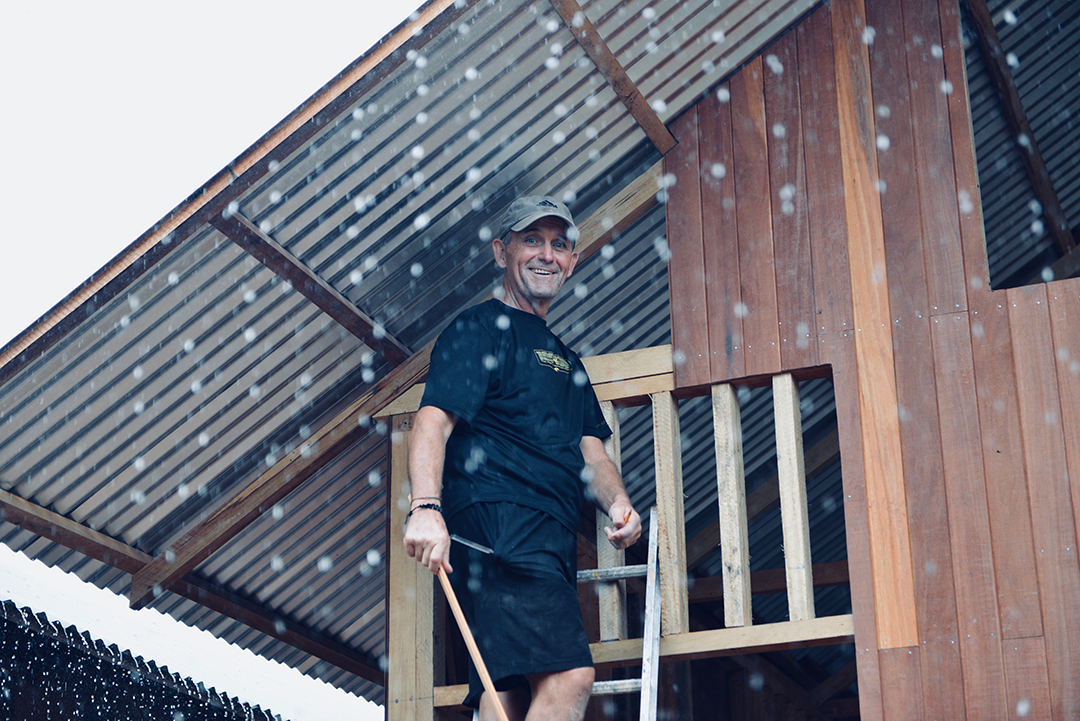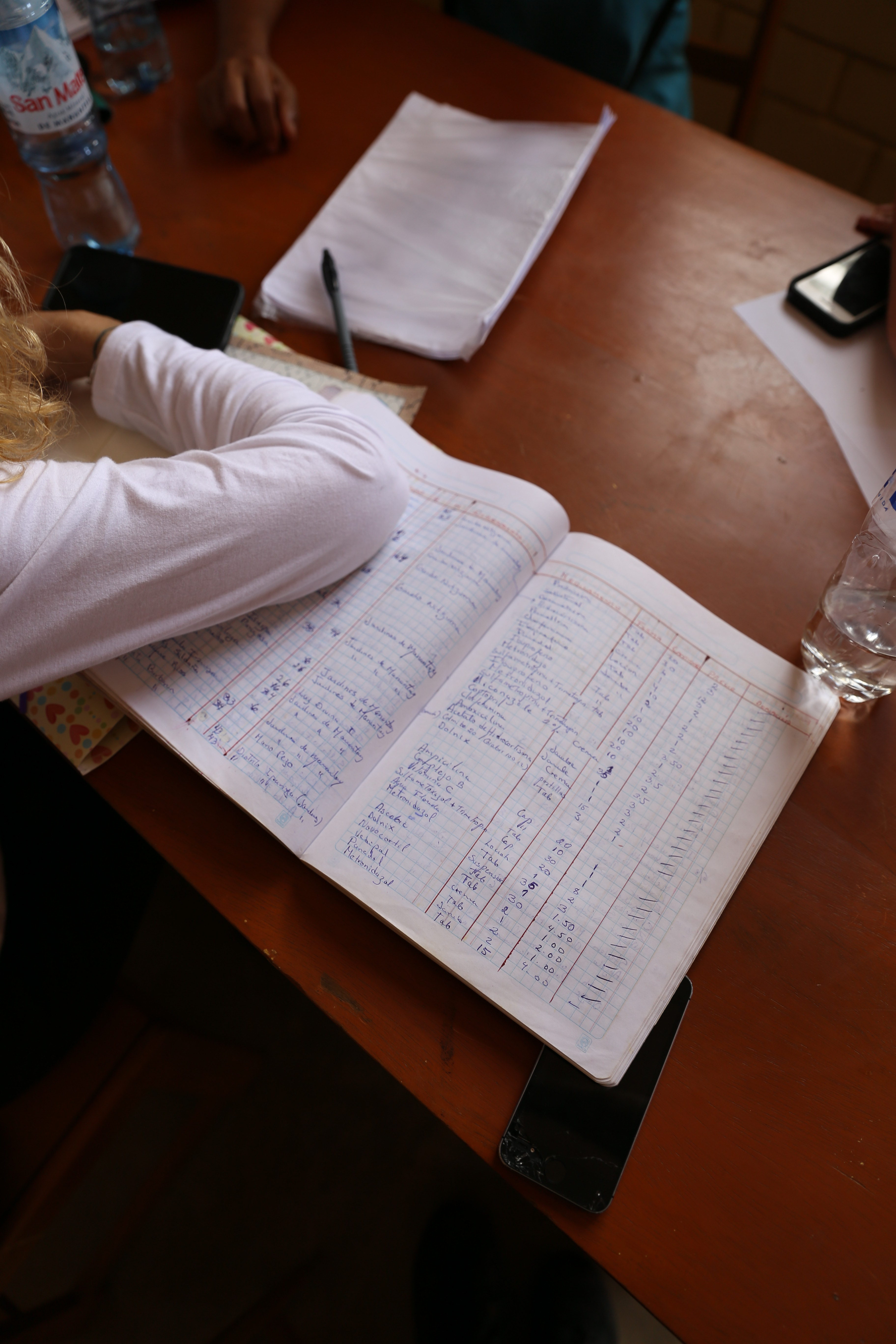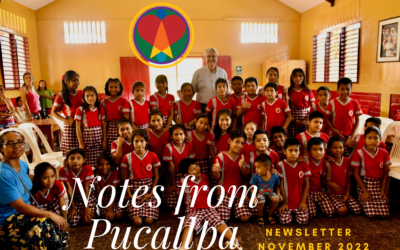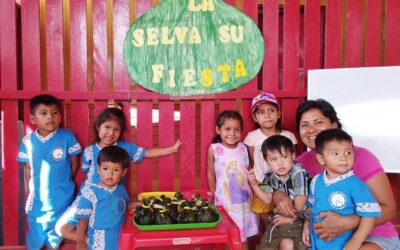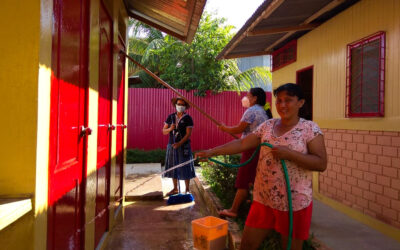We’ve arrived (at last!) in the heat and humidity of Pucallpa, ready for the week ahead with excitement. For this year’s trip, a record-breaking number of 65 international volunteers have joined us. From England, France, Vancouver, Vermont, Montreal and Toronto, we flocked together like birds headed for common ground: the Hub of Hope in the slums of Manantay, Pucallpa.
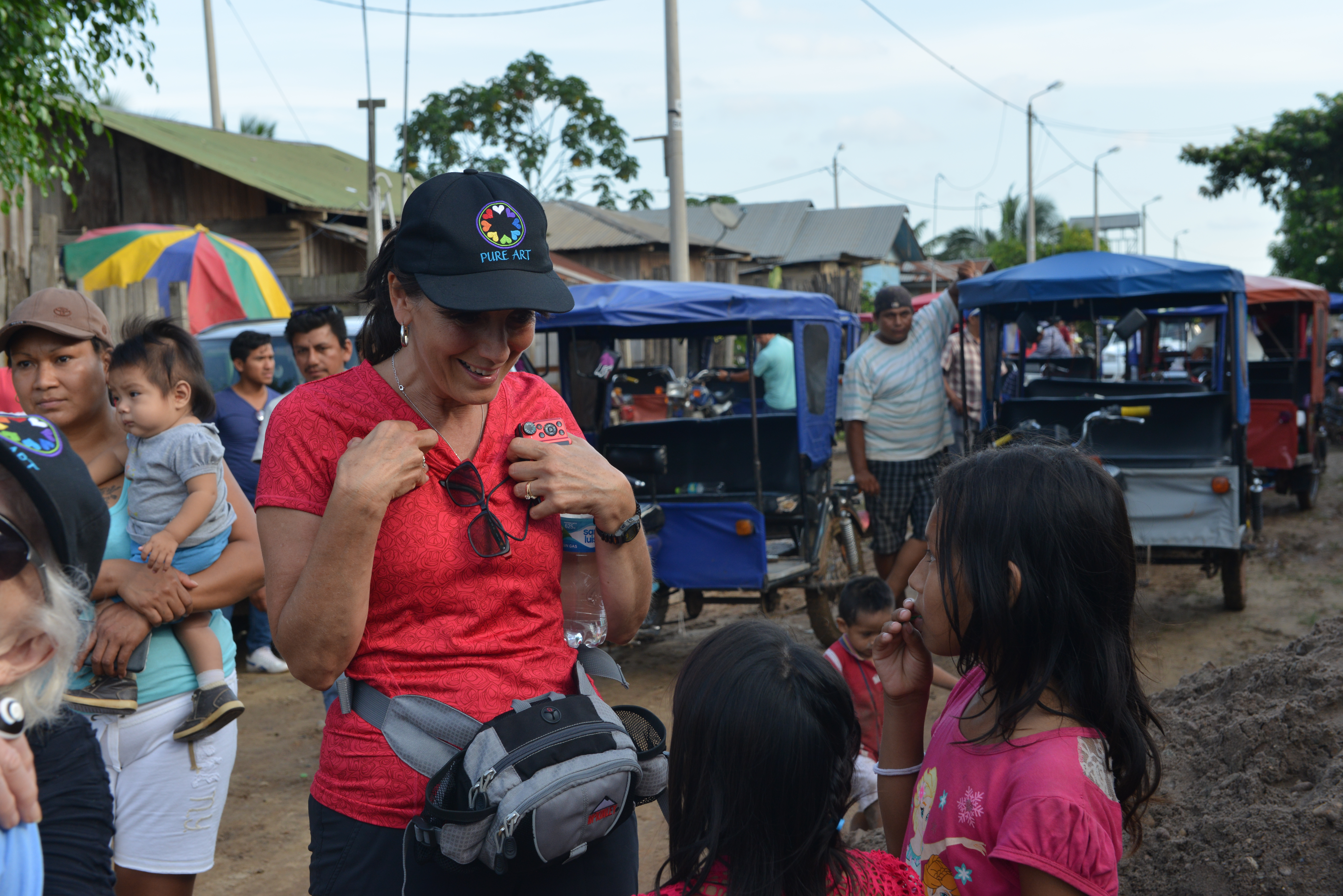
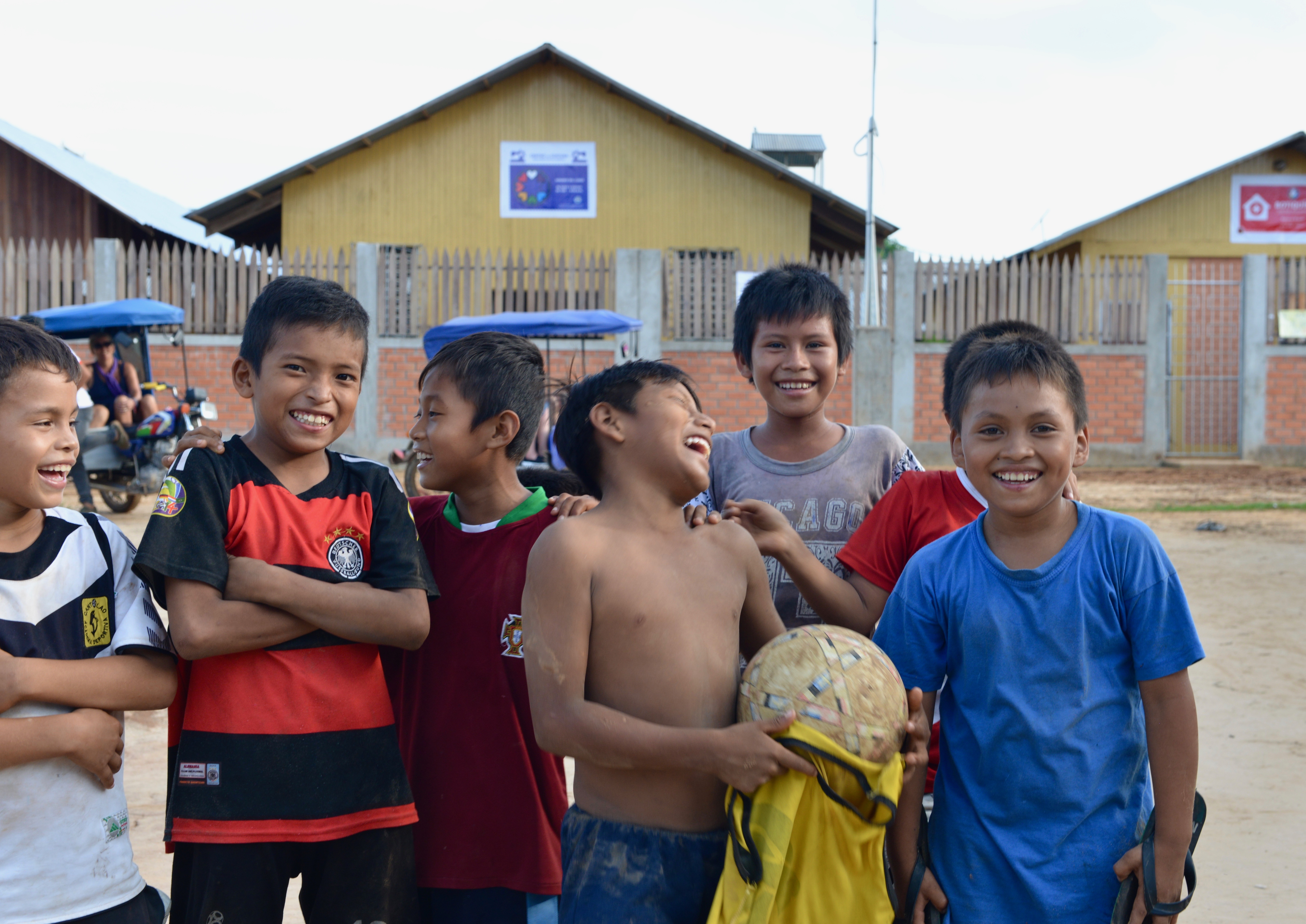 Eleven years in the making, the Hub is familiar ground for many of us. The children wait for us at the gates, many of them remembering us by name or at least by face, the reunion emotional for many. Hugo, the foreman of the Peruvian construction team, shakes my hand from the doorframe of the soon-to-be daycare “El Cuidador de la Luz”, The Lightkeeper, in memory of Ben McKinnon. Tomorrow, the earth floor of the daycare will begin to be excavated so that a cement foundation can poured from the hands of Ben’s family. Meanwhile, volunteers will be busy on the two additional construction sites that are currently and quickly adding up to Pure Art Foundation’s 27th and 28th homes in Pucallpa.
Eleven years in the making, the Hub is familiar ground for many of us. The children wait for us at the gates, many of them remembering us by name or at least by face, the reunion emotional for many. Hugo, the foreman of the Peruvian construction team, shakes my hand from the doorframe of the soon-to-be daycare “El Cuidador de la Luz”, The Lightkeeper, in memory of Ben McKinnon. Tomorrow, the earth floor of the daycare will begin to be excavated so that a cement foundation can poured from the hands of Ben’s family. Meanwhile, volunteers will be busy on the two additional construction sites that are currently and quickly adding up to Pure Art Foundation’s 27th and 28th homes in Pucallpa.
Day one began headstrong with a mass medical clinic at the Hub. Nurses, doctors, and a dentist were on sight to offer first-line health care to over 400 patients. Like last year, the clinic was organized by the Yarina Cocha Rotary Club and provided for by the foundation’s medications and vitamins.

After lunch, as many of the volunteers headed to their respective work sites, others stayed behind to follow up with the Hub of Hope’s hired pharmacist, Delicia Mercedes, who will bee overseeing the STOP campaign’s administration of vitamins and anti-parasitic medication.
She explained the challenge of ensuring follow-ups with children after they’ve received an initial dose of medication, in order to assure sustained immunity or recovery from parasites. With translation support from sister Marie-Colette, an administrator of the Hub, we discussed the idea of creating patient files to help keep track of the children that will soon be enrolled in the daycare, currently being built immediately next door to the pharmacy. Delicia mentioned that when the weather permits families to visit her, she easily treats 20 to 30 patients daily.
As the Hub’s pharmacist, she also visits families and certain patients in their homes. This morning, she brought to our attention the case of a 22-year-old boy who is battling a form of leprosy, but who is unable to access treatment due to its cost and the inaccessibility of appropriate clinics. She led us to his home, only a few doors down from where our volunteers were sawing wood and nailing walls, a house I’d passed earlier that day without realizing the dire situation of its occupants.
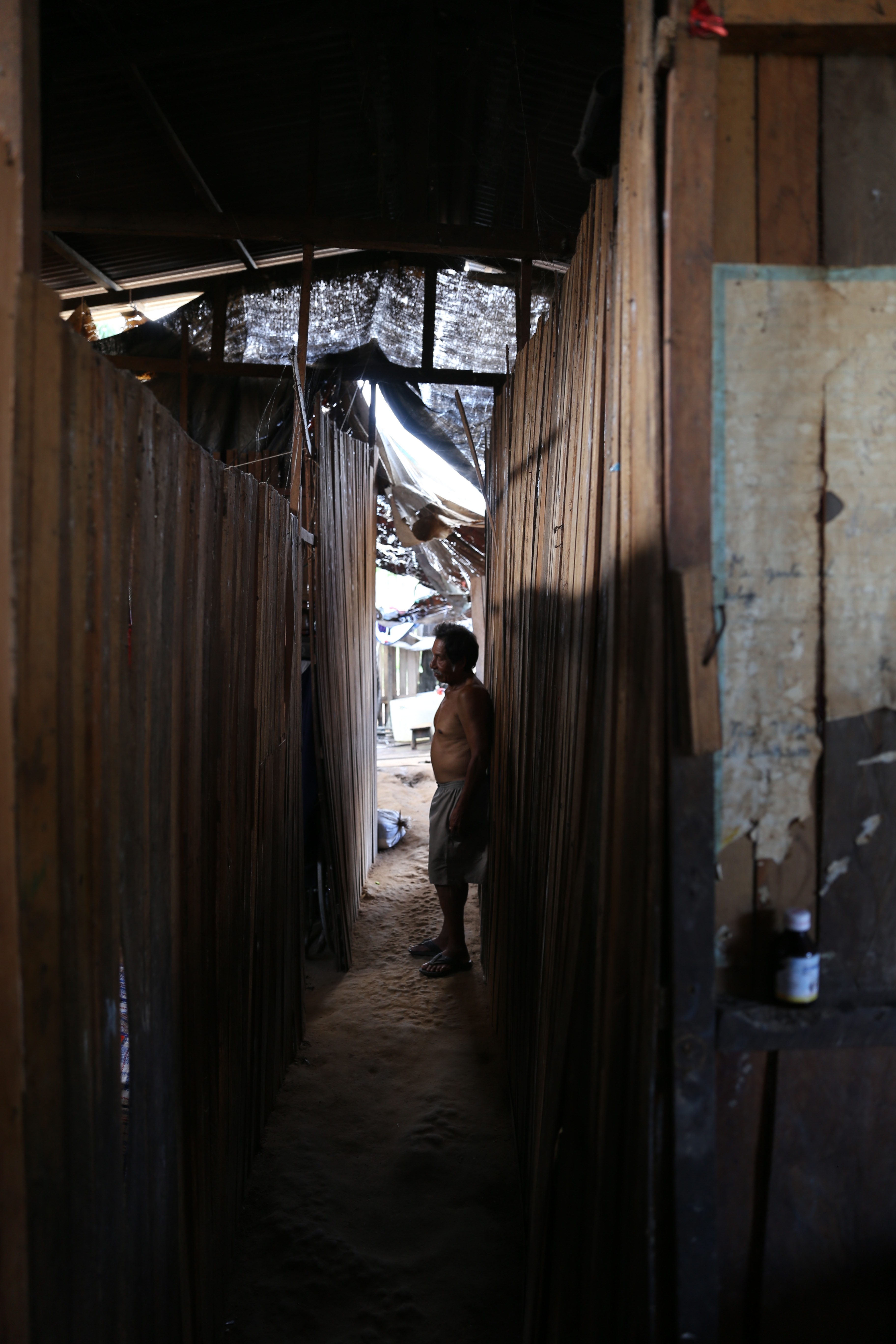 The small, make-shift home currently shelters a family of 15, on a piece of land that can be taken from them at any moment due to lack of recognized ownership. We met the boy, smiling politely from his bed though clearly in pain, as his mother massaged his legs showing sores and answered our questions; he started developing the disease at 17. I felt conflicted about photographing this setting, documenting a reality so needing of urgent attention, while also wishing to respect this boy’s privacy and dignity.
The small, make-shift home currently shelters a family of 15, on a piece of land that can be taken from them at any moment due to lack of recognized ownership. We met the boy, smiling politely from his bed though clearly in pain, as his mother massaged his legs showing sores and answered our questions; he started developing the disease at 17. I felt conflicted about photographing this setting, documenting a reality so needing of urgent attention, while also wishing to respect this boy’s privacy and dignity.
The Foundation has agreed to look into what can be done for this unique and pressing situation as soon as possible, once the condition and necessary treatment are more fully understood. Updates are to follow.

4:00 and a slanting sun was quickly upon us afterwards. The bus and convoy of motorcars picked us up from the Hub and unwound us through the red streets of Manantay. Down quiet drives or alleys, the yearly Humisha (Carnaval) trees can be seen erected with balloons and gifts, awaiting the festivities of the approaching evening. As some of the motorcars ahead were being ambushed by water buckets or blue and pink paint balloons, iconic of the early March celebration, I kept wondering about the walls that enclose families, their stories, their ailments and their hopes from the world. How everything from the outside— a clothes line, a child’s toy truck, a dog feeding on scraps, a face in a window — all looks ordinary, or seen before. Until someone asks for you to see inside, vulnerable as it is, and asks for help.
Day 2:
On the agenda for our second day, we had cement mixing and pouring for the daycare’s foundation, we had more walls to nail and the Hub’s fences to paint, and we had the first of two stages of the school children’s registration night.


 As the crew prepared for these various tasks this morning, I returned to Luis’s home — the young man we’d met yesterday who is struggling with a rare form of leprosy. This time, in addition to sister Marie-Colette, I was accompanied by Dr. Lucas — a Tanzanian physician who has been living and working in Pucallpa for the past thirty years — who agreed to visit Luis and his family to assess what could be done.
As the crew prepared for these various tasks this morning, I returned to Luis’s home — the young man we’d met yesterday who is struggling with a rare form of leprosy. This time, in addition to sister Marie-Colette, I was accompanied by Dr. Lucas — a Tanzanian physician who has been living and working in Pucallpa for the past thirty years — who agreed to visit Luis and his family to assess what could be done.
Luis’s many siblings, ranging from toddlers to late teenagers, greeted us with smiles as their grandmother poured them breakfast in cups from a stove pot. Luis himself was out of bed, sitting against the wall of their outdoor kitchen. Marie-Colette told me that she was relieved to see him looking happier than yesterday, though he still struggled to rise when Dr. Lucas suggested they go inside for an assessment. The 22 year-old reached for his cane first, then leaned on his father for support. “His sores have gotten so much worse in one year,” Marie-Colette said to me afterwards. She insinuated that infection will be inevitable.
Dr. Lucas explained that it appeared to be tuberculoid leprosy, which is a milder and less contagious form of the disease. If left untreated, however, disfigurement and permanent nerve damage are consequential. Luckily, Luis will be seen tomorrow morning in the Pucallpa hospital where Dr. Lucas works. Afterward, a route to proper treatment (and hopefully recovery) can be established. In the motocart on the way back to the city to drop Dr. Lucas off at the hospital, he told me that, years ago, he’d actually written his doctorate thesis in Hamburg on Tuberculoid Leprosy. Now, with the care needed for Luis, this story was coming full circle.
 By the time I was back in the Hub, half the daycare’s foundation was poured and drying in the afternoon sun. Next door, in the sewing centre, 26 women were gathered for their registration day in the Sewing Program. In the coming year, they will learn both craftsmanship and entrepreneurial skills; many of them decide to open micro clothing/textile
By the time I was back in the Hub, half the daycare’s foundation was poured and drying in the afternoon sun. Next door, in the sewing centre, 26 women were gathered for their registration day in the Sewing Program. In the coming year, they will learn both craftsmanship and entrepreneurial skills; many of them decide to open micro clothing/textile  businesses from the comfort of their own home. Others go on to work for larger companies. The result, in either case, is that these women are able to contribute to the earnings of their household, and provide for their families with a sense of independence. Each of the women there today will have a child enrolled in the daycare (once construction is completed) so that they may learn and work comfortably knowing that their children are being looked after.
businesses from the comfort of their own home. Others go on to work for larger companies. The result, in either case, is that these women are able to contribute to the earnings of their household, and provide for their families with a sense of independence. Each of the women there today will have a child enrolled in the daycare (once construction is completed) so that they may learn and work comfortably knowing that their children are being looked after.
Some volunteers were sitting in the shade with local children on their shoulders while others asked us to make them water balloons. They climb us to ride on our backs and tell us to race like caballos. A young girl offers us a go at her floral hula-hoop. These are the last days of their summer vacation, spent in the streets of Manantay. Their school registration was held tonight at the local parish. The One School for All program volunteers were busy all morning shopping and prepping gift bags for the students who eventually arrived in pressed uniforms and neatly coiffed hair. “It’s one of the most exciting nights of the year for them,” program coordinator Suzie Côté said. They come to get their photos taken and meet their sponsors while the coordinators update their student dossiers. As of yet, the program sponsors, on a yearly basis, the education of 245 students (between elementary and high-school) and some 25 university students. The demand is ever growing.
During the registration, a boy who caught my attention was 12 year-old Ernesto. Back in 2012, the foundation built Ernesto and his family a new home, with a proper bedroom and mattress for his mother who was paralyzed, and prior to then had been living on a hard surface. In 2012 Ernesto was 6 (photo below) and I’d spent the afternoons with him in the shade of the trees outside the construction site teaching him how to write basic words and numbers in Spanish and English.
Tonight, his grandmother — who has cared for him since the death of his mother — took me aside and told me that Ernesto’s uniform was different now because he was entering his first year of high-school. “He’s never had to repeat a year,” she said to me in Spanish. “He’s always getting good grades.” More than pride in this woman, I sensed a deep love and protection for her grandson, and her recognition of the importance of education in his life. When we departed form the registration centre later that afternoon, I caught sight of Ernesto sharing his candy with her on a park bench. They waved goodbye, smiling.
Day 3:
Our third day in Pucallpa was marked by sudden and heavy rainfall right after lunch. As the streets of Manantay turned to red mud and the tin roofs amplified the echoing rain; some children took the opportunity to get wet and dance and pull a few volunteers in with them.
This morning, we’d carried on with the tasks leftover from yesterday: the daycare’s cement foundation was completed and set to dry. Photographs of Ben McKinnon (pictured below), whom the daycare is commemorating, were laid by his family and covered in the foundation. Sister Marie-Colette, when seeing a photograph of Ben that I carry with me in my journal, told me that she can no longer feel alone here whenever she thinks of him and of his spirit being memorialized on these grounds.
Meanwhile, more stretches of the Hub’s fences were painted by any pair of hands that managed to grab a paintbrush. The local children enjoy helping out wherever they can and take serious part in the development of their community centre. The two C.A.S.T. sites also developed in impressive speed, with nearly all the walls complete by mid-day. In the last moments of fierce Amazonian sunshine, the children organized a soccer game in the adjacent yard while others drew us pictures on scraps of paper or proposed wheel-barrow races. Some asked to be taken in our arms where they grew tired and rested, suddenly very still.

 Next-door to all this action, the women’s sewing centre was busy in its first day of workshop. Lima-based fashion designer Anais Yucra Mancilla led the workshop with the goal of creating a template for the sewing centre’s upcoming commission: after eight years of communication and prospective partnership between Anais and Pure Art, everything is finally in place for the sewing centre to start creating products that will be sold in Pure Art’s Canadian-based fair trade boutique.
Next-door to all this action, the women’s sewing centre was busy in its first day of workshop. Lima-based fashion designer Anais Yucra Mancilla led the workshop with the goal of creating a template for the sewing centre’s upcoming commission: after eight years of communication and prospective partnership between Anais and Pure Art, everything is finally in place for the sewing centre to start creating products that will be sold in Pure Art’s Canadian-based fair trade boutique.

Cathryn Joly-Terriah, a second-time volunteer who is currently studying fashion at Lasalle College in Montreal, also partook in the workshop, helping Anais prepare the templates. It is the children of the 26 enrolled women who will soon benefit from the Hub’s daycare centre while their mothers enhance their craftsmanship. For the time being, they watch curiously as their mothers’ fingers snip, measure, fold and sew. As the workshop drew on (perhaps a little too long) for their attention, they met and played games with the soon-to-be animator of the Cuidador de la Luz daycare. Outside, the rain continued to hammer.
Later this evening, the second half of the school registration session was completed. The month of March marks the beginning of the academic year in Peru. Excitement and pride emanates from the children. In the courtyard of the parish where they gather, we can’t help but feel proud for them, and of them. The same children that we see playing soccer in the red mud and riding in dusty wheelbarrows, appear an hour later in impossibly white shirts and socks, their hair slicked and uniforms pressed.
In no time, we’ll be right back in the dirt and heat of the construction site, getting paint-splattered alongside them. But tonight, in composure and smiles, we celebrate their achievements and potential, wishing them only the best of luck in the pursuit of their dreams. 

Day 4:
March 7th, 2018
On Day 4, the team took a break from the construction site to travel upriver to visit the Shipibo town of San Francisco. The townspeople greeted us on the banks of the swollen Ucayali; March is the rainy season in the Amazon, and we’ve been lucky to have intermingled bouts of sunshine and rainstorms during our stay. As I’m writing these words from the shelter of sister Colette’s home, the cascading rain has just ceased and thunder is rolling onward outside.

In San Francisco, the Shipibo introduced our volunteers to their dance, music, jewelry and intricately sewn textiles. For the last eight years, Pure Art has been purchasing beaded necklaces and jewelry from San Francisco’s community to offer support through trade. The bags and clothing that Pure Art imports are from a separate Shipibo community further upriver named Limongema. These Amazonian products gain access to a global market through Pure Art’s fair-trade boutique in Hudson, Quebec.
Meanwhile, back in the Hub’s sewing centre, Lima-based designer Annaiss Yucra Mancilla was guiding the women through their second day of workshop. While the first day focused primarily on pattern and prototype design, today kept the women busy with pattern cutting and fitting. Volunteer and fashion student Kathryn Joly-Terriah partook in the workshop once again — this time by offering to test the finished templates on herself.
Founder Brigitte McKinnon told me later that creative consensus can be “the biggest challenge” when creating an artistic partnership with various groups. She smiled as she recollected how the Shipibo women (who’ve travelled from Limongema) seemed perplexed and unsatisfied by the colour palettes selected by Anaiss and Brigitte herself. The Shipibo’s garments are always bright and vibrant, leading them to consider the workshop’s decided colours as bleak and uninteresting. “The important, and difficult, thing to communicate,” Brigitte told me, “is an understanding of what will sell on a North American or international market while relying on the cultural motifs as the base of the design. It’s all about adjustment.”
Color schemes also entered into volunteer Manon Montpetit’s experience of Pucallpa this year. On our first day on site, Manon was approached by the family whose home she funded and built last year. The eldest son of the family, whose education Manon sponsors, asked her if she would be willing to buy them paint so that they could offer their hallway and living room a touch-up. Of course, Manon was delighted, and even more so when the family of boys decided on fuchsia for the living room and lime green for their hallways. “It definitely brightens up the place,” she said, “and makes it feel merry.”
The sewing workshop was followed by a meeting with Scotiabank manager Jesus Francisco Chávez Jaregui, who oversees the CSR (corporate social responsibility) facet of Scotiabank’s Pucallpa branch. Jaregui visited the Hub of Hope and met with the foundation’s administrators to discuss future involvement. We were so pleased by Scotiabank’s enthusiasm toward the projects, and by its decision to offer volunteered information sessions, to be held at the Hub of Hope on Saturdays, that will teach women about micro-financing, funds required for a business, family budgeting and financial growth. Sister Colette will communicate the community’s specific interests and needs to Scotiabank who will respond with a scheduled program.

How grateful we are to be ending each of our days in Peru on such uplifting notes! Even more so when we were visited by Dr. Lucas during dinner, who reassured us that twenty-two year old Luis — whom we met earlier the week, battling an advanced stage of tuberculoid leprosy — will begin treatment immediately in Pucallpa’s hospital under Lucas’ care. Upon the doctor’s request, some volunteers scheduled a morning appointment to donate blood for Luis, who is currently severely anemic. “One life at a time,” Brigitte and Robert McKinnon concluded tonight, stating that the foundation’s reach will only strive to grow broader and stronger over the years.
Day 5:
March 8th, 2018
On the morning of Day 5, eight of our volunteers met Dr. Lucas at the gates of Pucallpa’s city-centre hospital to give blood and allow the commencement of Luis’s treatment. We waited in the “sitting room” — an open-roofed alleyway by the blood bank where mud and rain puddles stained doctors’ shoes, or the wheels of a stretcher carrying a sheet-covered body — while the nurse tested our blood one by one. Since Luis is O+, the nurse kindly turned most of us away for being of other blood types, or for having low haemoglobins, or even for having thin veins! Luckily, three of our eight were of the sought blood type, and donated the litre that Dr. Lucas needed to commence treatment.
By the time we joined the rest of the team at the Hub, the week’s workload we’d come here to complete was beginning to wind down. Rain caught up to us yet again, dragging thunder in its wake this time. Painting proved difficult but possible under the shelter of the roof’s overhang, as the daycare was transformed stroke by stroke from wooden-brown to an optimist’s yellow, iconic of the foundation’s structures in Manantay. Both C.A.S.T. sites were also officially completed. As of now, the Amasifuenrios-Taricuarima family and the Alégria-Pérez family have solid walls, a reliable rain-repellent roof, and a dry concrete floor as a basis for the place they call home. These standards (minimal, at the least) are replacing make-shift walls of discarded junk metal and roofs made from strung garbage bags. Each family has three young children and live in the vicinity of the Hub of Hope. Señora Taricuarima is also enrolled in the sewing program, and her five-year-old Julia will soon be able to benefit from Hub’s daycare. Toddlers have already begun registration!
Both C.A.S.T. sites were also officially completed. As of now, the Amasifuenrios-Taricuarima family and the Alégria-Pérez family have solid walls, a reliable rain-repellent roof, and a dry concrete floor as a basis for the place they call home. These standards (minimal, at the least) are replacing make-shift walls of discarded junk metal and roofs made from strung garbage bags. Each family has three young children and live in the vicinity of the Hub of Hope. Señora Taricuarima is also enrolled in the sewing program, and her five-year-old Julia will soon be able to benefit from Hub’s daycare. Toddlers have already begun registration!
Things were also coming to fruition in the sewing centre with the end of Annaiss’s three-day workshop. By the evening, once the rain had ceased and most of the volunteers had returned to base, I found Annaiss in the lamplight by a sewing machine, inspecting the final touches of the completed dress and shirt the women had been working so hard on to finish in time. A mini fashion show was scheduled for that same night, to showcase the finished products and encourage the women to believe in the legitimacy and value of the clothes they will be creating.

Sister Colette, Brigitte, and Kathryn were also in the centre, enjoying the celebratory cake that had been cut earlier in the day; two sewing machines were donated to women of the program who had distinguished themselves last year by their attendance, participation, collaboration, and punctuality of fee payments (that ensure the centre’s electricity and water access). A third sewing machine was also gifted to the women of Limongema, as a token of thanks and encouragement. I was offered a piece of cake and ate from a napkin while the women finished up under Annaiss’s guidance; the clouds were a dark gold outside and frog choirs were ringing in the soaked streets, coming through the Hub’s open doors and windows.
A few hours later, clapping and cheers filled the hotel courtyard as Annaiss’s completed designs — sewn by the women of the Hub and completed with the Shibibo’s tribal motifs — were paraded by volunteers Kathryn Joly-Terriah and Lulu Lovering. The second-to-last night in Pucallpa always marks the “Gala” event wherein we celebrate the programs’ successes and most importantly the Peruvian volunteers who keep the programs running once we’re back on Canadian soil. It is a night of music and dancing, of cultures coming together to appreciate hard work, international exchange, and the unrelenting belief in a fairer world.
Day 6: March 9th, 2018
And just like that, a week speeds by. Our boots are caked in red mud, our shirts specked with yellow paint. Clothes are hung to dry over the hotel’s bannisters, overlooking the courtyard where, soon, we’ll be gathering our luggage and preparing our goodbyes. But first, we make one last trip to the Hub, to revisit what we’ve accomplished here. To hug the children one last time. Hanging off the back of a motocart parked outside the Hub’s gates, one asks for my bracelet, another for my sunglasses, anything to remember us by. One boy who’s shadowed us all week, Messi, just kept repeating “I don’t want you to go.”
For these children, where we come from is a hazy concept: it’s a dot on a map, it’s a string of letters that reads C-A-N-A-D-A. It is a place that we arrive from and return to, like a house after a day of playing out in the streets. All that the children want to know is, “when will we back?”
For many of us, it’s next year. For others, this time away was a singular experience. But to visit Pucallpa, even only once, is to have a print left in one’s personal map. It is a more nuanced understanding of one’s world — a place where poverty and resilience, health crises and joy, education shortages and opportunity — are intermingled in a complex web that we have, somehow, found ourselves implicated in. It is a place where our actions have a direct and undeniable effect. Pucallpa is a reminder of the vast imbalances that persist between people, communities, and countries, and of the daily opportunity we have to adjust that imbalance. To help people reach the state of living that they inherently deserve.
Our week began by meeting 22-year-old Luis, battling tuberculoid leprosy without medical attention. It began by arriving on two construction sites that held shells waiting to be built into homes. It began by preparing wheelbarrows, shovels, paint and paintbrushes, for a daycare not yet existent. It began by meeting children who were in the last hours of their summer vacation and women who did not know their own capacity as seamstresses.
Our week ends with Luis being entrusted into supervised care from Pucallpa’s hospital and undergoing immediate treatment. It ends with two brand-new homes for the Alégria and Amasifuenrios families, expanding the Hub of Hope’s periphery. It ends with the foundation of a daycare laid for the children who will soon learn and play on its floors. It ends with women having their capacities both broadened and validated at the completion of a workshop. It ends with almost 300 students in pressed uniforms enrolled and ready for school.

Our week here draws to a close with arms reaching for a hug goodbye. Hands clasped to say Thank you. Children waving ciao! in front of a yellow fence. It ends with the unspoken desire to do more for them. The desire to hasten change and to continue, even once back home, to mobilize our individual capacity and privilege in the pursuit of equality.
It’s been a joy to share these reports with you. Should you want to know more about any of our programs , each of them are described in depth on this website. Or, should you like to get in touch regarding specific queries or comments, the Contact Us tab will connect you to us directly.
Until next time,
The Team

